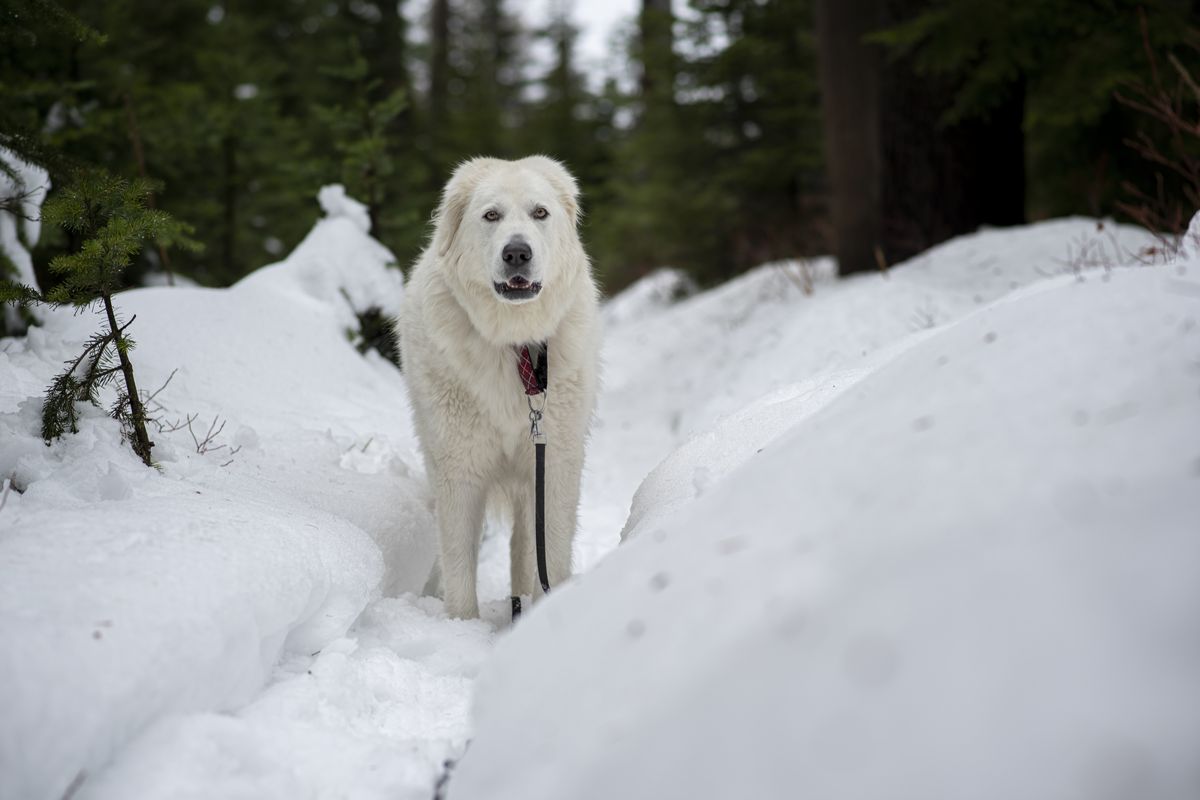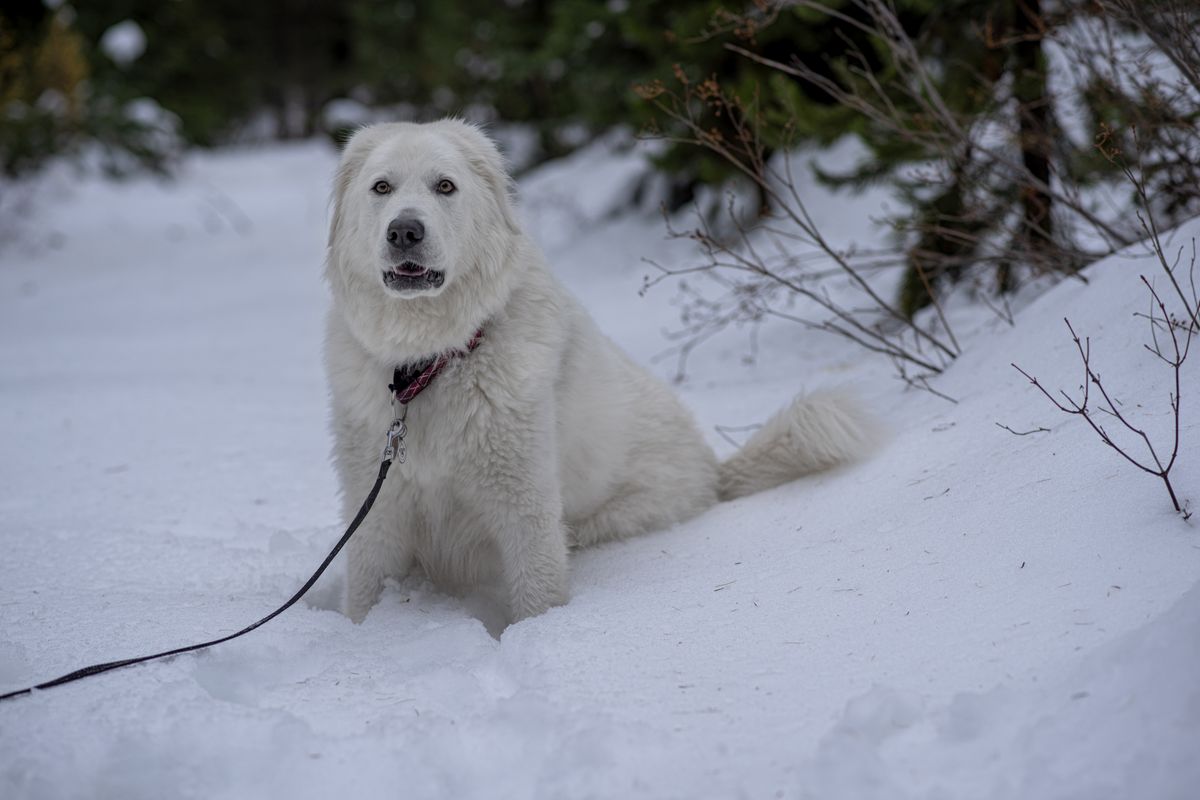Hiking with dogs: Winter romps with our best friends

Some outdoors people hang up their hiking boots when winter descends.
The rest of us squeal with glee at the sight of snow falling from the sky, knowing we can bust out our snowshoes or snow cleats and head for more adventures with our dogs.
While we’re pulling our thermal layers and gaiters out of storage, though, we also have to consider preparing our best fur friends for winter hiking.
Dan Hanks, who’s raced in the world skijoring championships, knows a thing or two about getting dogs ready for cold-weather adventures.
He’s stationed in Winthrop, Washington, these days and surrounded by dogs. Lacey, the girl in his pack, just whelped 10 puppies.
Winthrop is a haven for dog-friendly ski and bike trails. In between puppy feedings and cleanings, he’s been getting the boys ready for winter.
And that’s all about conditioning them – similar to humans training for a half-marathon.
“I am a psychologist so I think behaviorally,” Hanks said. “I try to get the dog into work mode. The first outings don’t have to be big ones. The first 10 skis, I stick to only 1 or 1½ miles.”
He sees the frustration in his dogs. They want to run for as long they can.
“But if you push too hard,” he said, “you can impair their trust and they won’t want to do the activity. So it’s important to build up to longer hikes or skis.”
The same goes for the speed at which you might want to hike or ski with your dog. In the skijor and sled dog community, Hanks said, most injuries come in association with too great a rate of speed, or letting the dog run too fast, too far, too soon.
“When they’re punching through the snow, it puts a lot of strain on the shoulders,” Hanks said. “Those muscles aren’t developed early in the season. We have an acronym, LSD, which stands for ‘long slow distance.’
“In our community speed is king, but if you lead with it, you end up hurting your team over the long-term trajectory.”
His advise for winter hikers: Restrain your dog with a leash and go slowly.
“Dogs want to go 20 to 25 miles an hour all the time,” he said. “We have to downshift and keep them to 15 for a while before we should let them get up to speed.”

How to accessorize your dog in the winter
Anyone with a hairy, double-coated dog doesn’t have to worry about this part. Some dogs, especially livestock guardian dogs, are built for working and sleeping outdoors in all weather. Their growth of undercoat protects them not only from the freezing cold but also sun exposure.
Nonwinter dogs, especially the short-haired breeds, can grow a little extra coat to keep them warmer on winter adventures, Hanks said.
“My dogs are mostly mixes of German short-haired pointer and greyhound,” he said. “If I leave them outside for longer periods of time, they will develop an undercoat. My dogs sleep inside but with long play sessions outdoors, they grow a coat.”
If your dog still doesn’t bulk up his fur, it might be a good idea to get them a sweater or a jacket.
Feet are another area of concern.
Hanks spends a lot of time on foot care for his sled dogs.
“Because I have six,” he said, “people always ask, ‘Do you even know all their names?’ Not only do I know all their names, but I know what the inside of the pad on each paw of every dog looks and feels like. I know every foot on every dog, whose pads get dry, whose pads get cracked.”
He often makes his dogs wear booties made from soft Cordura fabric for protection from snow and ice. He buys them by the hundreds and keeps spares in his pocket while out on the trail.
Hanks often sees adventure dogs wearing harder, rubber-soled boots.
Bad plan.
“A dog’s foot is meant to spread on contact with the ground, much like ours,” he said. “The rubber soles prevent that from happening, so using those boots can lead to injury.”
If you’re worried about your dog’s pads on the snow, Hank suggests applying a layer of zinc-based lubricant, like Desitin, which prevents diaper rash on baby tushies. It’s a thin layer of protection and it can prevent ice balls from building up on their hair in between the pads.
It’s also a good idea to grab some self-adhesive wrap and tape down a dog’s dew claws.
Hanks uses horse wrap from the top of the Cordura bootie to well past the dew claw. It secures the bootie from falling off and protects the dew claw.
“Your dog can rip off the dew claw by pushing down through the snow,” he said. “We have one trail in Winthrop that’s really popular with dogs and I always see blood drops all over the snow. I know it’s from partially torn dew claws.”
Brings snacks … but just for yourself
It might be tempting to bring food for your dog. After all, winter hiking has high calorie-burning potential.
Not so fast, Hanks said.
It isn’t necessary and you could be putting your dog at risk of bloat and torsion, he said, citing research from one veterinarian, Dr. Arleigh Reynolds, a senior research nutritionist for Purina and professor of nutrition at the University of Alaska Fairbanks.
Reynolds said the optimal time to feed a dog is 24 hours before a big adventure or race and then again when the day is done – but only after the dog has cooled down.
Hanks follows this protocol but gives dogs that need an energy boost some maltodextrin, the active ingredient in runners gels.
“It’s like Gatorade for dogs,” he said. “We often think dogs need the same things we do. Like for a half-marathon we need to take sugar in, but their digestive process works a lot differently than ours. Most animals don’t perform physically until they need to eat.”
A bonded connection that’s addicting
No matter how much time you get ready for winter hiking with your dog, nothing can prepare you for the joy you’ll feel while you’re actually out there.
The time spent together is special.
Hanks is addicted to the drug of dog-human connection.
“Yeah, that camaraderie,” he said. “When you’re hiking, skiing or biking together, you’re the closest you’re going to be to the dog’s world.
“When they’re on the couch with you, you don’t get the experience of being in the pack with them. In the outdoors, they bring you into their bonding world.”
That shared experience, he said, is amazing.